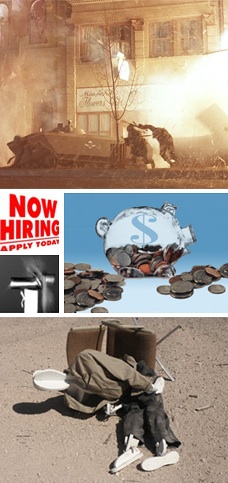
een two of ma
ny high p Dr. John Meason
otreros and on into Water Canyon where the road followed the narrow valley for a few miles. We crossed a winding creek several times and drove through green pastures until the high-walled canyon became narrow. Presently, the road turned to the left
winding up the side of the mountain. Fortunately it was not muddy or we might never have made the steep grade. Once on top of the plateau the road headed south and a little west in the direction of Frijoles Canyon a few miles distant. We wound through majestic yellow pines, pifions and scrubby junipers. Here the road turned again and paralleled the Canyon for a few miles, up and down hills, ever twisting and turning. We drove to the top of an old trail which might have been used by ancient Indians some four hundred years ago. I walked to the brink of the Canyon, my mother constantly reminding me not to go too near. The height was terrific. It must have been six hundred feet to the bottom of the gorgeÑalmost straight down. It made me dizzy. I had never seen such a thing before in all my life. It was to me a Hidden Valley and I wondered why any people wanted to come away out here to live even prehistoric Indians. Of course, it wa
s awe- inspiring but I was too young to be inspired. There were saddle horses at the brink of the Canyon for folk who couldnt or who were too lazy to walk down the trail. And then there were benches and tables underneath the pines for picnickers who wanted to eat either before they began the long descent into the valley, or after they returned from it. For years and years people walked or rode horseback up and down the steep old trail. Perhaps some never reached the bottom. Individuals came from all over the world. Some painted, some viewed some fished, some wrote and some prayed to God that they might; make it back to the top. Others, enthralled by the grandeur-of the Canyon, desired to cast themselves off its rim into the mystery of its depth. I myself distinctly remember climbing down that old winding trailfrom the north rim. It seemed that we would never reach the bottom. The trail was a precipitous one, zigzagging and narrow, to the valley floor far below. At a short distance across the narrow
Rio we could see a little stone ranch house surrounded by huge pine trees and box-elders. A woman was standing on the porch probably wondering if we were to be guests for the night at the famous "Ten Elder Ranch." But my father and I were fishing for mountain trout, and, if I remember correctly, it was he who caught the limit because he was the fisherman, not I. I might have been includ
ed among those unschooled people who had in their blood simply the desire for "pioneering" and "roughing- it," but who understood little about what they saw. This excursion of ours

